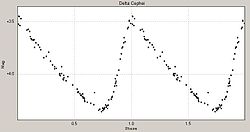Delta Cephei

Delta Cephei (δ Cep, δ Cephei) is a binary star system about 887 light-years away in the northern constellation of Cepheus, the King. At this distance, the apparent magnitude of the star is reduced by 0.23 as a result of gas and dust along the line of sight.[1]
Delta Cephei, found by John Goodricke in 1784, was only the second Cepheid variable discovered.[2] It is very important because its distance is extremely well known. This is partly because it is in a star cluster,[3][4] close enough for the precise Hubble Space Telescope/Hipparcos parallaxes to give a good result. As a result, it is known as a "fundamental distance calibrator", or absolute candle.[1] Delta Cephei is a classical, or type I, Cepheid variable.
The only Cepheid variable closer to us is Polaris, the North Star, whose distance is still not exactly known.
Delta Cephei is emitting around 2,000 times the Sun's luminosity. This is producing a strong stellar wind, which, with the pulsations and shocks in the star's atmosphere,[5] is ejecting mass at the rate of (1.0 ± 0.8) × 10–6 solar masses per year. This is the equivalent to the mass of the Sun roughly every million years. The matter is flowing outward at a velocity of about 350 km s–1. This expelled gas forms a nebula about one parsec across, centered on Delta Cephei, and contains 0.07–0.21 solar masses of neutral hydrogen.[6] A bow shock is being formed where the stellar wind is colliding with the surrounding interstellar medium.[7]
Delta Cephei Media
Phase-folded UBVRI light curves of Delta Cephei showing magnitude versus pulsation phase.
Hermes Radial Velocity Curve of Delta Cephei A. The offset between points of identical color is due to the spectroscopic companion, Delta Cephei B.
References
- ↑ 1.0 1.1 Benedict, G. Fritz et al 2002. Astrometry with the Hubble Space Telescope: a parallax of the fundamental distance calibrator δ Cephei, Astronomical Journal 124 (3): 1695–1705. [1]
- ↑ The first was Eta Aquilae earlier the same year.
- ↑ de Zeeuw P.T. et al 1999. A Hipparchus census of the nearby OB associations. Astronomical Journal 117 (1): 354–399. [2]
- ↑ Majaess D.; Turner D & Gieren W. 2012. New evidence supporting cluster membership for the keystone calibrator Delta Cephei. Astrophysical Journal 747 (2): 145. [3]
- ↑ Neilson, Hilding R. & Lester, John B. 2008. On the enhancement of mass loss in Cepheids due to radial pulsation. The Astrophysical Journal. 684 (1): 569–587. [4]
- ↑ Matthews L.D. et al 2012. New evidence for mass loss from δ Cephei from H I 21 cm line observations. The Astrophysical Journal 744 (1): 53. [5]
- ↑ Fazio G. 2010. Discovery of an infrared bow shock associated with Delta Cephei. Bulletin of the American Astronomical Society. 41: 839. [6]



